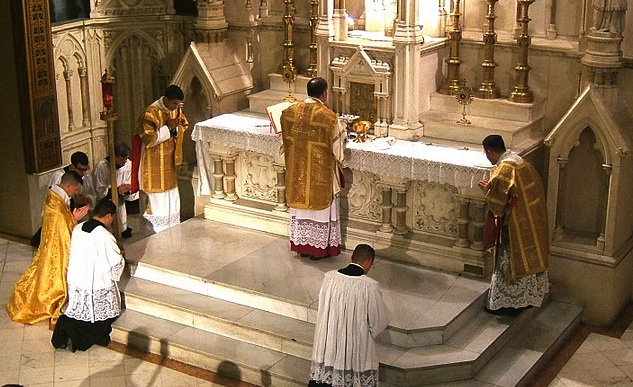Last updated on: August 29, 2014 at 1:31 pm
By
tmatt
There is this old, old, old saying that you will often hear quoted in discussions of worship trends in the modern and postmodern Catholic church. It goes like this.
Question: What is the difference between a liturgist and a terrorist?
Answer: You can negotiate with a terrorist.
Now, you either get that joke or you don’t. If you get that joke, then you probably are the kind of person who cares a whole lot about discussions of why Catholics can’t sing anymore, why so few men go to Mass and why it matters whether people are allowed to kneel when receiving Holy Communion. On that latter subject, I once wrote:
While it is hard to explain to outsiders, one of the most fascinating battles in the American Catholic church today is the one that pits the kneelers vs. the non-kneelers. I refer, of course, to the issue of whether bishops should — bowing to the modernization of ancient rites — attempt to prevent the faithful from kneeling before the altar as they receive Holy Communion during the Mass.
Let me explain: If people are allowed to kneel, that would mean that the Latin Mass is coming back and the next thing you know the pope will be seeking draconian student-life codes on Catholic campuses that prevent student funds from being used for activities that directly attack Catholic doctrine. It would be like the reforms of the Second Vatican Council never happened (or the spirit of the council has been quenched or something like that). Horrors.
Yes, note the reference to the Latin Mass.
You see, there are millions of Catholics who really, really, really hate the modern, post-Vatican II rite that is used in the vast majority of Catholic parishes. I am serious about the word “hate.”
At the same time, there are plenty of Catholics wearing Roman collars — some of them professional liturgists in dioceses across America and around the world — who really hate (I think “distrust” is too mild a word) the many Catholics who love very traditional forms of liturgy and, especially, the traditional Tridentine Mass. It also annoys these Catholic professionals that so many of the Latin lovers are older Catholics with checkbooks and a fierce dedication to sacramental life. Period.
With all that in mind, please consider the recent New York Times report — OK, it has been in my guilt file for some time — that ran under this double-decker headline:
Manhattan Parish Draws Attention of Conservative Catholics and the Church
Church of the Holy Innocents, Home of the City’s Only Daily Latin Mass, Might Close
Here is the top of the report:
As the Rev. Justin Wylie took the pulpit at the Church of the Holy Innocents in Manhattan last month, anger and anxiety emanated from the pews. Parishioners, who rely on the church to offer a daily traditional Latin Mass, were about to meet to discuss an archdiocesan panel’s recommendation to close their church, and some were talking about schism.
“I worry about the situation of traditional Catholics in the archdiocese,” Father Wylie, a visiting priest, said in his sermon,
articulating their concerns. “No longer, I say, should you think of yourselves as squatters in the mighty edifice of the Holy Church, nor should you find yourselves turned out like squatters.”
It was an unusual moment of open criticism by a Roman Catholic priest of church policy in New York. And the reaction was swift. Within two weeks, Father Wylie was reprimanded by the New York Archdiocese and in short order dismissed from his job as attaché at the Mission of the Holy See at the United Nations, where he negotiated human rights issues on the Vatican’s behalf.
And the kicker:
(more…)














